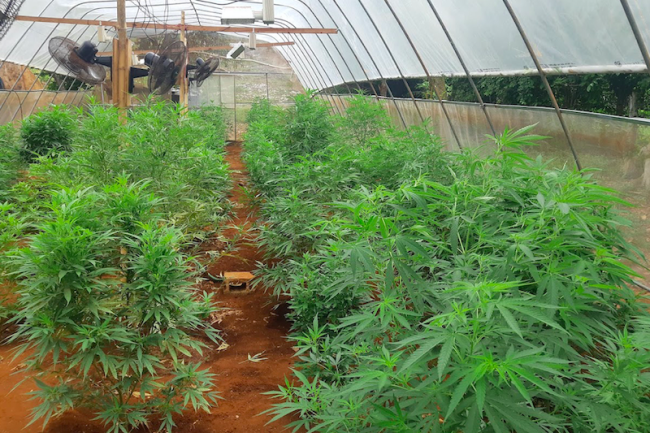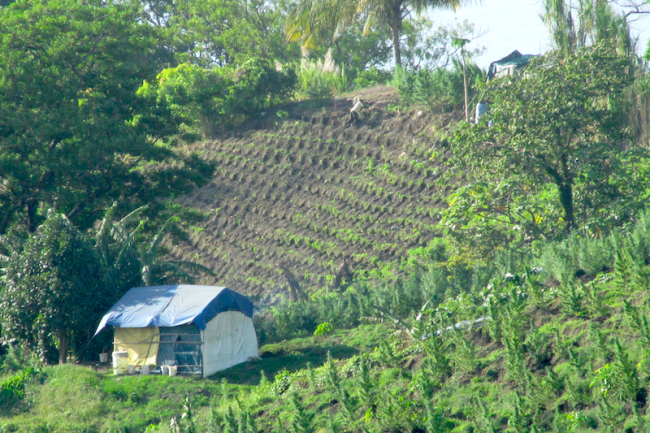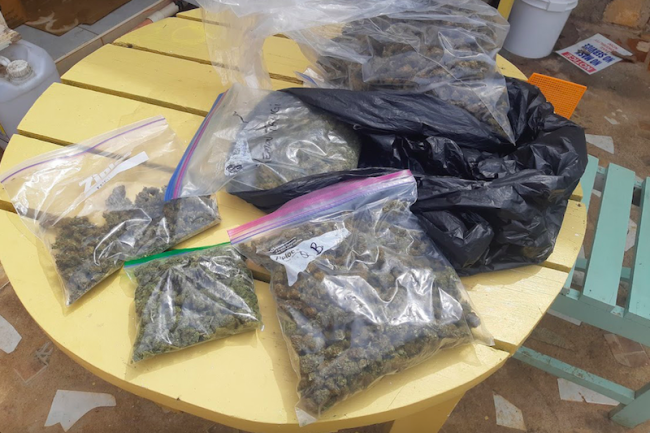
This piece appeared in the Fall 2023 issue of NACLA's quarterly print magazine, the NACLA Report. Subscribe in print today!
In 1976, reggae legend Peter Tosh released the album and title track Legalize It. Thirty-nine years later, Jamaica revised its ganja laws to build a legal medicinal cannabis (ganja) industry with the hopes of exporting to the world. Many assumed that Jamaica, and the historically marginalized traditional ganja growers, including the Rastafari, would finally be able to cash in on the green gold rush in an industry one venture capital firm called in 2018 “the most compelling opportunity in the history of capitalism.”
Today, it may come as a shock to some that the island infamously associated with prolific cannabis cultivation and consumption reported a shortage in 2021 and recently became an importer of Canadian cannabis. As a result, the most vocal opponents of Jamaica’s cannabis reforms are no longer the police or conservative church congregations, but the traditional growers and Rastafari themselves. How could such a seemingly transformative opportunity “go up in smoke” so quickly?
Legalization sounds like an obvious, responsible approach to the longstanding and wide-ranging damages stemming from cannabis prohibition and the subsequent war on drugs. However, given the social, economic, and political power imbalances within and between countries, it isn’t that simple. Unchecked, market-based reforms fail to consider the existing power imbalances in both the domestic and international economies, threatening to undermine the potential benefits of legalization. Instead of gaining employment and income-generating opportunities or access to scarce land, traditional cultivators will likely face greater hardships due to being shut out of the emerging legal industry. While often overlooked, these harmful afterlives of legalization and reform under capitalism are, as expected, filled with contradictions and will continue to compound damaging outcomes for the same communities that were disproportionately impacted during prohibition.
In the context of the Caribbean, the hard truth is that unless legalization is tied to a wider project of radical socioeconomic transformation and reparatory justice, many of the potential gains from cannabis will be lost due to the imbalanced and exploitative nature of the global economy. Without the emergence of mass movements to seriously challenge government policy, neocolonial states like Jamaica will always defer to domestic elites connected to international investors and corporations. As in the past, government policies shrouded in ostensibly progressive rhetoric will facilitate a massive dispossession of traditional ganja growers from their land and livelihoods in an unprecedented upward transfer of wealth. The consequences of this would be greater economic instability, inequality, unemployment, and violence.
The Plantation Economy: From Sugar to Ganja
My seeming pessimism about the future of the ganja economy is rooted in a critical understanding of the region’s history in relation to Caribbean agricultural production under free market capitalism, insightfully articulated by Plantation Economic Theory. Pioneered by economists Kari Polanyi Levitt and Lloyd Best in the 1960s, the theory explains the failures and frustrations of the post-independence period, particularly in terms of the lack of economic development and the outward-oriented political behavior of elites. The plantation was much more than a farm—it was a capital intensive, technologically advanced totalitarian ordering of land, labor, and capital. It both was predicated on and reproduced colonial violence, dispossession, and exploitation, and it eventually institutionalized dependency by creating lasting domestic economic structures, political institutions, and behavior patterns.
Examining Caribbean economies through the plantation, the longest lasting and most influential Caribbean institution, helps us to understand the ongoing underdevelopment of countries in the region. More than half a century after independence, domestic politicians and capitalists continue to recycle colonial-era policies across industries such as sugar, bananas, tourism, and now ganja/cannabis, robbing domestic economies of an internal dynamic capable of generating self-sustained growth.

The engrained plantation mentality has also structured the behaviors of domestic elites and, in turn, state policy. According to political economist Don D. Marshall, policies prioritizing short-term, risk-averse investment have produced a culture that values “the ease of commerce over the challenge of industry.” The building of domestic and regional economies has routinely been neglected, creating a disconnect whereby the region produces what it does not consume and consumes what it does not produce.
This is where ganja economies across the Caribbean have traditionally offered an important point of departure from the plantation—for now. Domestic ganja economies helped to create jobs and income for otherwise economically marginalized communities that were deemed “surplus populations” and were traditionally shut out from foreign and/or public investment.
Across the Caribbean, ganja economies are sophisticated examples of a grassroots social safety net and a social economy rooted in self-sufficiency. These ganja economies have been so successful that they often dwarf even the largest legal industries like tourism and sugar, generating billions of dollars in income and thousands of jobs. They have also bypassed the rules of formal land tenure that had previously excluded many of the poor from meaningfully engaging in productive activity. These often-overlooked positives must be recognized and protected in future reforms.
Ganja as an Economic Driver
In The Political Economy of Drugs in the Caribbean, political scientist Ivelaw L. Griffith states that the study of narcotics issues must be multidimensional. He calls on scholars to recognize that drugs have “positive-sum aspects” and that in many communities they can be a key driver of “income generation, employment creation, and resource distribution, no matter how skewed.” For centuries, the historical combination in the Caribbean of outward-oriented economies that failed to meet the needs of the domestic majority, and weak states—themselves a product of capitalist underdevelopment—has always engendered the creation of alternative, informal economies deemed “illicit” by the state.
In 2015, Jamaica became one of the first countries in the world to undertake ganja reform by decriminalizing small-scale marijuana possession and cultivation, in addition to legalizing ganja use for religious purposes. The changes also opened the door for licensing the production and distribution of medicinal marijuana.
Despite these reforms, harmful drug war policies remain in place for unlicensed, non-Rastafari cultivators, as they still face regular threats of eradication, heavy fines, and/or imprisonment for producing over and above the ganja law’s small-scale five-plant limit. According to the 2021 International Narcotics Control Strategy Report, in the first nine months of 2020, Jamaican police—working in collaboration with the United States—eradicated 253 hectares of ganja plants and seized 26 metric tons (approximately 57,000 pounds) of cured ganja, both measures up from the previous year. Although Jamaica has not yet established mechanisms that would allow for a transition into the legal industry, repeated calls from traditional cultivators for an amnesty on cultivation and moratorium on eradication until licensing procedures are in place have been ignored. This approach reflects the state’s apparent desire to create a more secure market for large, legal investors while targeting those who historically built up the industry.
The importance of ganja in bolstering Jamaica’s national economy has been something of a very public secret since the mid-1970s. As trade barriers came down, local producers could not compete with cheaper U.S. agricultural imports, resulting in a sharp increase in unemployment, poverty, and inequality. This in turn drove a large portion of the peasantry toward work in ganja. “Because of the desperate nature of the economy,” Jamaica’s then prime minister Edward Seaga told CBS’s Face the Nation in November 1980, “…it [marijuana] has played a far more important role.” Ganja had “almost been the lifeline economically in providing dollars and foreign exchange,” he added. By the mid-1980s ganja was arguably the island’s most valuable cash crop, worth an estimated $1 to $2 billion in revenue.

Today, very little has changed in terms of Jamaica’s continued reliance on ganja. Although accurately estimating the size of Jamaica’s illicit cannabis markets remains challenging due to a lack of reliable statistics and data, there are two ways to measure the ganja economy based on available information. The first method uses seizure statistics, and the second is related to agreed-upon cultivation statistics. Using very conservative metrics from these two methods, my calculations place Jamaica’s ganja economy at the wholesale level between $3.2 billion and as high as $9.6 billion. In March 2023, Jamaican economist and politician Andre Haughton put the value at $11 billion. Even the lowest estimate of these three easily makes ganja one of Jamaica’s biggest economic contributors, coming in right behind tourism, which totaled $3.64 billion in 2019, prior to the Covid-19 pandemic. While these numbers are staggering, they only provide wholesale estimates. The retail value of the ganja economy and its respective contribution would be many times higher.
In Jamaica’s other economic sectors, producers receive economic assistance in the form of brand promotion, infrastructure aid, tax breaks, and other incentives. Even in the wake of decriminalization, this assistance does not extend to the ganja industry. The difference mainly lies in who holds the balance of power. In older industries like sugar and tourism, ownership is often concentrated among a handful of people, many of them from the old planter families on the island. The ganja economy, on the other hand, is greatly dispersed between rural communities, which have largely been shut out of investment and development plans. Nevertheless, independent commodity production by traditional cultivators has helped to build a bottom-up, community-based, multibillion-dollar domestic and regional industry without any government assistance.
From the days of slavery onward, the mountainous, relatively abundant Crown Lands and uncultivated private property in the interior of Jamaica acted as a Caribbean form of the commons. These lands were accessible to traditionally landless ganja farmers who, beyond having to invest sweat equity and endure the looming threat of eradication, did not face traditional barriers to accessing land to establish crops. This cultivation of the commons provided widespread opportunities for employment and income generation, and social relations of production were based on the values of mutual aid, cooperation, and self-management. In this way, the ganja plots on untitled land in the mountains acted as a modern-day provision ground, and through a system of mutual aid, teams of ganja farmers cultivated significant amounts of illicit product, supporting numerous communities and making a significant economic contribution to both the island and the region.
These factors helped to turn the illicit ganja trade into an important, organic, grassroots alternative and challenge to the plantation economy. While imperfect, traditional ganja economies demonstrate many positive features of self-organized solidarity economies, providing an alternative model of survival that allows many traditionally marginalized communities to collectively meet their needs in the face of market and state failures. Independent production has thus provided an example of an elusive rural development model that breaks away from the longstanding and enduring legacy of the plantation.
Against this backdrop, the legalization of ganja in many ways falls into the model of accumulation by dispossession, as the industry provides a new source of raw materials, labor, and markets that had previously existed outside of formal capitalist/foreign control. This dynamic is particularly evident in relation to access to common land and communal, subsistence resources. In this sense, the widespread independent production of the traditional growers stands in stark contrast to the increasingly common sharecropping model whereby landowners provide landless growers access to land for a disproportionate share of their revenues.
Read the rest of this article, available open access for a limited time.
Kevin Edmonds is assistant professor of Caribbean Studies at the University of Toronto.

